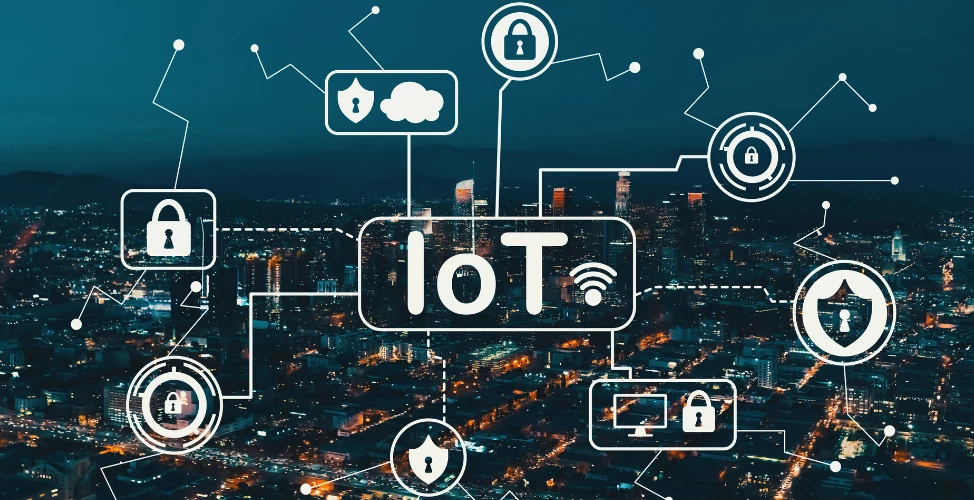June 25, 2021
Scalable IoT Application Development for Thai Enterprises
The Internet of Things (IoT) is transforming industries like manufacturing, logistics, and healthcare through automation and real-time insights. To harness its full potential, businesses must invest in scalable IoT application development—the backbone for managing connected devices and data-driven decisions. This blog explores what IoT application development entails, its benefits, and how SmartOSC helps Thailand enterprises build future-ready solutions.

What Is IoT Application Development?
Definition and Overview
IoT application development refers to the process of designing and building software systems that enable internet-connected devices—often referred to as “smart devices”—to collect data, communicate with other systems, and perform automated tasks based on predefined logic or real-time input. These applications act as the critical layer that bridges physical devices (such as sensors, machines, or wearable tech) with cloud infrastructure, user interfaces, and data analytics tools. As of the end of 2024, there are approximately 18.8 billion connected IoT devices worldwide, reflecting a 13% increase from the previous year, underscoring the rapid expansion and significance of IoT in modern technology ecosystems.
Unlike traditional software applications, IoT applications must be built to operate reliably across distributed environments, often under constraints like intermittent connectivity, low power, or limited bandwidth. In this context, IoT software not only manages device communication but also orchestrates data processing, control logic, and user interaction, all while maintaining security and compliance.
A robust IoT system allows organizations to remotely monitor assets, assess operational performance, and execute automated or manual actions in real time—enabling predictive maintenance, resource efficiency, and intelligent automation across various sectors. Successful implementation relies heavily on strategic application development to ensure the system is tailored to specific business needs and seamlessly integrates with existing workflows.
A complete IoT solution includes:
- Device firmware to enable sensing and communication
- APIs and protocols for device-to-cloud and cloud-to-device interaction
- Cloud platforms for data storage, analysis, and orchestration
- Mobile or web dashboards for end-user control and visualization
- Security frameworks to ensure compliance and data protection
Key Components of an IoT Application
To function efficiently and securely, every IoT application must be designed with a modular architecture comprising these essential components:
- Devices/Sensors – Collect real-time data from the environment or equipment
- Communication Protocols – Such as MQTT, HTTP, CoAP, or Bluetooth for reliable data transmission
- Cloud Backend & Data Lakes – To store and analyze large volumes of sensor data
- User Dashboards & Mobile Apps – Provide control, monitoring, and analytics
- Security Layers – Ensure data encryption, user authentication, and PDPA compliance in Thailand
Why Thai Enterprises Are Investing in IoT Solutions
Smart Industry Transformation Under Thailand 4.0
Thailand’s Thailand 4.0 policy is a government-led initiative focused on transforming the country into a high-tech, innovation-driven economy. Emphasizing automation, connectivity, and digitization across key sectors like manufacturing, logistics, agriculture, and healthcare, the policy has created an ideal landscape for IoT application development. Industries aiming to shift from traditional, labor-intensive operations to smart, data-driven ecosystems are now increasingly investing in IoT solutions to align with this national vision.
IoT plays a central role in this transformation by enabling:
- Smart factories with real-time production insights
- Connected logistics systems with automated delivery and fleet management
- Digital healthcare platforms with patient monitoring and predictive diagnostics
Competitive Edge Through Real-Time Insights
In a dynamic, digitally competitive marketplace, speed and accuracy of decision-making are critical. IoT solutions empower Thai enterprises to move from traditional reactive approaches to real-time, proactive management—unlocking greater control and responsiveness across business units. For example:
- Fleet managers can reroute deliveries instantly
- Retailers can automate inventory restocking
- Manufacturers can predict failures before downtime occurs
These real-time insights are not just operational conveniences; they are powerful drivers of agility, precision, and customer experience. Companies that can respond to data as it happens are better positioned to personalize services, streamline operations, and deliver faster turnaround times—giving them a clear competitive edge in the Thai and ASEAN markets.
Cost Efficiency and Predictive Maintenance
Another major driver for IoT adoption in Thailand is the financial efficiency it offers. By embedding sensors and smart controllers into business infrastructure, companies gain the ability to monitor asset performance continuously, enabling predictive maintenance strategies that drastically reduce repair costs and avoid unplanned downtime.
Here’s how IoT contributes to long-term cost savings:
- Monitoring equipment health to enable predictive maintenance
- Reducing energy waste through smart building systems
- Improving resource allocation in agriculture and logistics
Over time, these efficiencies translate into significant cost savings and sustainability gains.
See more: Best Practices in Custom Application Development for Thai Businesses
Business Benefits of Scalable IoT Application Development
As more Thai enterprises integrate the Internet of Things (IoT) into their digital ecosystems, the ability to scale IoT applications effectively has become a critical success factor. Whether a company is piloting a small network of devices or expanding across multiple sites and regions, scalability ensures that the application can grow with the business—without sacrificing performance, security, or usability.
Developing IoT systems with scalability in mind not only maximizes long-term ROI but also enables businesses to respond to new demands, explore new use cases, and future-proof their technology investments. Here are the core benefits that scalable IoT application development offers to Thai enterprises:
- Real-time data visibility across multiple sites, factories, or geographies
- ERP, CRM, and analytics integration for streamlined enterprise workflows
- Centralized control over distributed sensors, machines, or systems
- Support for multi-device environments and large-scale device rollouts
- Future expansion of features and devices without needing full reengineering
Whether you’re deploying ten devices or ten thousand, scalable IoT architecture ensures consistent performance, manageability, and growth flexibility.
Common Use Cases of IoT Application Development in Thailand
Thailand’s growing digital infrastructure and strong push for Industry 4.0 have made the country a fertile ground for the widespread adoption of IoT applications across sectors. As Thai enterprises strive for smarter operations, real-time insights, and better resource utilization, custom-built IoT applications are unlocking measurable efficiencies and transformative outcomes. Below are some of the most prominent and impactful use cases in the Thai context.
Manufacturing & Smart Factories
- Machine Monitoring & Performance Tracking: Sensors capture real-time data on equipment usage, production speed, and system health, enabling supervisors to monitor KPIs and production efficiency remotely.
- Predictive Maintenance: Vibration, temperature, and pressure sensors alert maintenance teams before machinery breaks down, preventing costly downtime and extending equipment life.
- Energy Efficiency Optimization: IoT-powered control systems automatically adjust power consumption for HVAC, lighting, and production equipment based on occupancy and usage patterns—significantly reducing utility costs.
Logistics & Supply Chain
- Fleet Tracking & Route Optimization: GPS and telematics data allow logistics companies to track vehicles in real time, adjust delivery routes dynamically, and improve driver performance.
- Cold Chain Monitoring: For industries like food, pharmaceuticals, and chemicals, temperature and humidity sensors provide live updates and automated alerts if storage conditions fall outside of safe thresholds.
- Asset Tracking & Anti-Theft Measures: RFID and IoT-enabled asset tags help businesses track valuable equipment, pallets, or containers—enhancing inventory accuracy and reducing theft or loss.
Smart Agriculture
- Soil & Climate Monitoring: IoT sensors collect data on soil moisture, temperature, nutrient levels, and weather forecasts to guide irrigation schedules and planting decisions.
- Automated Irrigation Systems: Connected pumps and valves regulate water distribution based on real-time soil readings, helping farmers optimize water usage and reduce waste.
- Crop Health & Pest Detection: Computer vision and sensor technology detect early signs of disease or pest infestation, enabling timely and targeted intervention.
Healthcare & Wellness
- Remote Patient Monitoring (RPM): Wearable devices track vital signs such as heart rate, blood pressure, oxygen saturation, and glucose levels. This allows doctors to monitor high-risk patients in real time—especially critical for eldercare and chronic disease management.
- Smart Hospital Systems: IoT-enabled tracking systems manage bed occupancy, patient location, and equipment availability—ensuring smoother operations, reduced wait times, and better patient care coordination.
- IoT-Based Drug Dispensing & Diagnostics: Automated pill dispensers and point-of-care diagnostic tools increase medication adherence and enable on-site testing in remote or underserved areas.
Smart Buildings & Real Estate
- HVAC & Lighting Automation: Sensors and AI algorithms adjust lighting and temperature based on occupancy, external weather, or energy tariffs—helping property managers cut energy consumption and improve tenant satisfaction.
- Air Quality Monitoring & Predictive Maintenance: Environmental sensors measure CO₂, PM2.5, humidity, and VOC levels, while predictive analytics trigger maintenance before HVAC or air purification systems fail.
- Access Control & Occupancy Tracking: Smart locks, facial recognition, and motion sensors automate entry systems and provide real-time insights into space utilization, improving both security and resource planning.
Key Considerations for Building Scalable IoT Applications
To ensure your IoT infrastructure is future-ready, Thai enterprises should consider the following:
- Use Cloud-Native Platforms: Choose AWS IoT, Azure IoT, or Google Cloud IoT for scalability and security
- Support Edge-to-Cloud Processing: Deploy edge devices for real-time responsiveness while syncing with the cloud for deeper analytics
- Prioritize Cybersecurity: Implement encryption, role-based access, and ensure PDPA compliance for data sovereignty
- Design for Device Interoperability: Use open standards and modular architecture to add or replace devices with minimal disruption
- Enable Analytics and AI: Build analytics dashboards and integrate AI tools to extract value from collected data and automate decisions
Why SmartOSC Is a Trusted Partner for IoT Application Development in Thailand
SmartOSC has helped enterprises across Southeast Asia successfully design, deploy, and scale IoT ecosystems. With a comprehensive understanding of both technical requirements and local business needs, SmartOSC offers a full suite of services tailored to Thai enterprises.
Here’s why SmartOSC stands out:
- Extensive IoT expertise with platforms like AWS IoT Core, Azure IoT Hub, and custom cloud-native stacks
- Proven track record in custom app development, data visualization, and API integration
- Local support teams familiar with Thai compliance laws, especially PDPA
- Full project lifecycle delivery—from IoT strategy, device integration, and dashboard development, to ongoing optimization
- Trusted by clients in logistics, retail, healthcare, and government for delivering reliable, scalable, and secure IoT applications
SmartOSC combines enterprise-grade development standards with local market expertise—helping Thai companies unlock the full value of IoT.
Watch more: Unlock the Potential of Application Development Software in Thailand
Conclusion
The Internet of Things is revolutionizing how Thai businesses operate, compete, and grow. From real-time analytics and predictive maintenance to smart city infrastructure and personalized healthcare, the opportunities are immense. But to capture this value, enterprises must invest in scalable IoT application development—solutions that are robust, secure, and built to grow with your business. SmartOSC brings the experience, tools, and regional expertise needed to turn connected devices into strategic assets. Ready to transform your business with IoT? Contact us to start your journey.
Related blogs
Learn something new today


